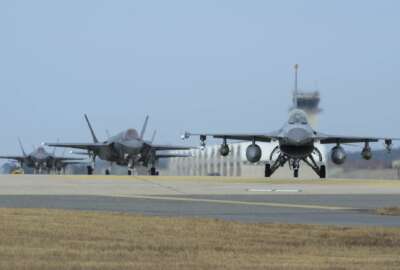
Space acquisition proposals held up amid DoD-OMB negotiations
Lawmakers probably won't have time to slip ideas to better space procurement in this year's defense policy bill.
The DoD Reporter’s Notebook is a weekly summary of personnel, acquisition, technology and management stories that may have fallen below your radar during the past week, but are nonetheless important. It’s compiled and published each Monday by Federal News Network DoD reporters Jared Serbu and Scott Maucione.
Space acquisition reforms still on hold
Part of the reason for creating a Space Force was to simplify the complex and leaderless acquisition process for space systems. However, the Department of the Air Force’s legislative proposals to help make that process happen keep hitting snags.
Air Force Deputy Assistant Secretary for Space Acquisition Shawn Barnes told reporters the report lawmakers have been waiting for is held up with the Office of Management and Budget.
“We’ve got this old acquisition report, and we started drafting that from day one,” Barnes said. “It’s still not on the Hill. I’m a little frustrated by that, but I think we’re very close with OMB at this point. I think that we’re just about there.”
The proposals are part of a larger acquisition report the Air Force released in May that outline nine recommendations to improve space procurement.
Some of the proposals are pretty obvious, and can be conducted within the Defense Department and Air Force. For example, creating a separate topline budget for the Space Force or consolidating budget items by portfolio instead of by program.
Barnes said the Air Force and DoD are still working on those.
Three of the nine proposals require congressional help and lawmakers have been waiting for those details since the preliminary report came out.
Those include things like creating a space-specific major acquisition process with its own thresholds, definitions and milestone decision authorities.
Outside of legislative proposals, Barnes is keeping a close eye on the space industrial base as the coronavirus continues to impact businesses.
In June, Barnes said out of the 388 companies DoD polled, “About half have adjusted their business strategies for the next couple of years. More than a third have had schedule impacts, over half have seen supply chain workforce impacts, less than a third have seen supply chain materiel impacts.”
Barnes said he’s continuing discussions with companies, especially on an industry association level.
“I find that the discussions at the association level ended up being some of the most impactful because each company has their own business strategy and sometimes they don’t want any help because it might undermine the perception of them having a strong position,” Barnes said. “Others very much are in need of assistance. Working at the industry association level I think has been more fruitful to better understand kind of the broad challenges that are there.”
One thing Barnes recognized is that there was not enough information on the challenges third and fourth tier suppliers are facing.
“We just don’t have a real good sense of the challenges that they face,” Barnes said. “We’ve asked our tier one and tier two folks to go out and pulse the system down there to better understand what’s underlying all this. Are we going to have more fundamental challenges moving forward?” — SM
Contractors left out of DoD climate change plans
A yearlong Government Accountability Office review of potential climate change threats finds the Defense Department is underprepared when it comes to protecting contractors.
The report found DoD has “not routinely assessed climate-related risks faced by its contractors as part of its acquisition and supply processes, through which DoD obtains contracted goods and services.”
GAO said DoD’s climate change guidance is inherently flawed because it does not require the Pentagon to take into account extreme weather or climate change in regards to acquisition and supply, despite it being required in DoD’s climate change policy.
“Until DoD and the military departments include these considerations in their guidance on acquisition and supply chain processes, they risk continuing to develop acquisition strategies and managing supply chains without building climate resilience into these processes and potentially jeopardizing their missions,” the authors of the study state.
The department also has not assessed climate-related risks to commercially-owned facilities as part of mission assurance.
“We recognize that incorporating climate risk analysis into the DoD’s contracting processes in a systematic way is a challenging task, but the potential risks to DoD operations and mission-critical assets are significant,” Senate Armed Services Committee Ranking Member Jack Reed (D-R.I.) and Sen. Elizabeth Warren (D-Mass.) wrote in a joint press release. “If DoD fails to identify and address the impacts of climate change to its contracts and supply chains, it could jeopardize DoD’s ability to carry out its missions.”
GAO suggested six executive actions to better the situation, which involve DoD and the military services fully implementing DoD’s climate change directive by updating guidance.
“In doing so, DoD and the military services should consider providing guidance as to how departmental officials may leverage already existing information regarding private companies,” the authors recommended.
Reed and Warren asked DoD for an update on the departments progress by Sept. 15. — SM
Military telehealth is on the rise
Coronavirus is forcing the Army to do things differently and it’s no surprise that telemedicine is making a meteoric rise in the health community.
Army Surgeon General Lt. Gen. R. Scott Dingle said the service has increased its virtual health by 70%.
“It has been a phenomenal occurrence of increase in virtual health and the virtual medicine platforms,” Dingle said.
It’s likely that coronavirus will change the way medicine is delivered. Just as COVID-19 has put telework to the test and shown, in some cases, caused higher productivity, telemedicine may be a bigger part of the future than originally thought.
“It has been so successful that we are throwing a lot behind the continuation, the improvement and the expansion of telemedicine,” Dingle said. “We’ve funded out of our own pockets to support and reinforce and expand virtual health across the Army medical treatment facilities to include behavioral health too.”
The Military Health System (MHS) as a whole is seeing revolutions in medicine, much like ones caused by new forms of conflict.
“During the long wars in Afghanistan and Iraq, the MHS adapted rapidly to develop new medical products, new systems of care and did so in order to achieve historic rates of survival from combat,” Dr. Simon Pincus, chief of Connected Health at DHA, told reporters. “In 2019, the same system, the MHS, really pivoted quickly to use those same attributes to support the national and international response to stop COVID.” — SM
Copyright © 2024 Federal News Network. All rights reserved. This website is not intended for users located within the European Economic Area.
Scott Maucione is a defense reporter for Federal News Network and reports on human capital, workforce and the Defense Department at-large.
Follow @smaucioneWFED





